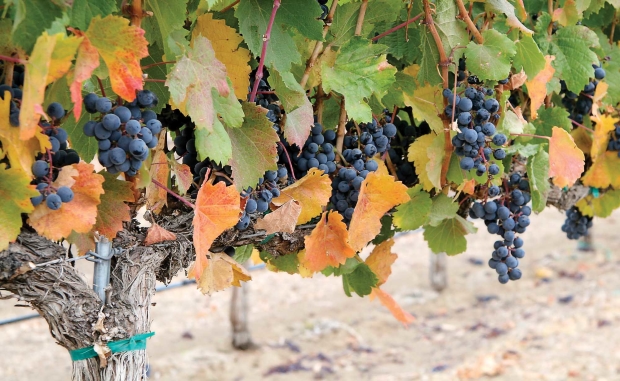
Malbec grapes, known for their dark, inky color and robust tannins, need lots of sun and heat to ripen. The variety is one of the six grapes allowed in the blend of Bordeaux wine. (Melissa Hansen/Good Fruit Grower)
Lesser-known wine grape varieties can be more work than they’re worth, considering the costs of extra management and risk in straying from the mainstream.
Related Stories
But if you get it right—matching site with variety and winery—these cultivars can help growers better manage labor and help wineries stand out in a crowded field.
Washington State can produce outstanding Cabernet Sauvignon, Syrah, and Merlot wines, and the state is the nation’s number one producer of white Riesling. But the state, with diverse growing regions, can also grow scores of other lesser-known wine grape varieties well.
These cultivars often tempt growers with high prices offered by wineries because of their limited quantity, but they come with risk.
Three wine grape growers, who spoke during a meeting of the Washington Association of Wine Grape Growers, agreed that homework is needed before planting to ensure you are prepared for what can be labor-intensive varieties and have a winery willing to buy the fruit.
Joe Hattrup, owner of Elephant Mountain and Sugar Loaf Mountain Vineyards, has worked with lesser-known varieties for about a dozen years. His two vineyards, at the west end of the Rattlesnake Hills appellation (a sub-appellation of Yakima Valley), are located at high elevations—from 1,150 to 1,460 feet.
He grows 18 varieties commercially and has several others planted in small test plots. Most of his blocks are spaced six feet between vines and nine feet between rows and contoured and terraced for his steep slopes.
Hattrup says the biggest consideration with lesser-known varieties is a site’s length of season. Lesser-known varieties tend to be late maturing and heavy producers with big berries and clusters.
Many, like Petit Verdot, Mourvèdre, and Cinsault, are 10 to 14 days behind Cabernet Sauvignon in a normal year. “Can you safely and consistently get high-quality fruit harvested?” he asked.
“Roussanne is terribly sun sensitive and sunburns easily, so canopy management is important,” Hattrup said. “Tempranillo requires early bird netting for me every year, and Grenache is extremely sensitive to winter temperatures and frost.”
Hattrup added that because most lesser-known varieties are heavy producers, irrigation must be managed differently than on Bordeaux varieties. He judiciously applies water early in the season to help control canopy.
“Careful water management is easy to do but takes consistent effort, and you may not get it right the first time.”
Growers should also factor in the need for labor-intensive crop load management—things like aggressive pruning, shoot thinning, leaf removal, and cluster thinning.
Changing his row orientation from north-south to northeast-southwest and using two catch-wires for wind, one on each side, helped him balance shade in the canopy and be more reactive to wind.
Nutrition needs of lesser-known varieties are also different than standard varieties.
He reduces nitrogen applications in lesser-known varieties by 50 to 100 percent compared to his Bordeaux varieties. “Our Bordeaux target is around 35 pounds of nitrogen annually. With heavy producers of the lesser known varieties, we’ll apply 18 pounds, or maybe none, for two or three years in a row.”
However, he makes an exception for Petit Verdot, which is a weak grower on his site, and gives it normal nitrogen applications and more frequent irrigations.

Roger Gamache
Grower and winery owner Roger Gamache likens his grapes to children.
“These varieties are like your kids,” said Gamache, who is co-owner of Gamache Vintners that includes an estate vineyard in Mesa and winery operations in Prosser. “Some are rowdy and challenging, like Roussanne, and some, like Malbec, make you proud. Malbec, for us, has done very well, and it’s been like watching one of our kids walk through graduation ceremonies.”
He urged growers to research varietals before planting.
“It’s very expensive to plant a vineyard, so do your homework. Know where the vines are coming from, what kind of climate, soil type, slope, and aspect are needed. You’ve got to go with certified, clean plant material because it’s just too costly to pull a vineyard out.”
Horse Heaven Hills’ Mike Andrews grows about 25 varieties of wine grapes, 19 of which are lesser-known varieties. The owner of Coyote Canyon Vineyard and Winery planted his first wine grapes in 1994.
“Make sure you have a contract before planting lesser-known varieties, and make sure the winery is financially stable,” he said. “Although wines from these varietals are getting a lot of publicity and media attention, when a shopper goes into a grocery store, they’re still an unknown. Remember that you’re planting a grape without a proven market, and it will be hard to find another buyer if you lose your winery.”
Lesser-known varieties require more management, says Hattrup. “You’ve got to like doing the extra steps. You really need to like growing these varieties, and so do your employees.”
Andrews added that white varieties require more water than red varieties.
Costs are usually greater with lesser-known varieties because of the extra management and labor involved in things like taking cluster shoulders off, explained Hattrup. “Extra steps mean extra costs.”
All three growers recommend that those with lesser-known varieties sell fruit by acreage contract and not tonnage because of the extra work required to meet winery expectations. Growers shouldn’t be penalized for the extra management steps, they say.
While the varieties often cost more to produce, there are positives involved with them, such as filling niche markets, attracting a wider base of winemaker customers, and diversifying a grower’s portfolio.
Hattrup said lesser-known varieties can help improve labor efficiencies, a major advantage with today’s tight supply of agricultural workers. With his diverse varieties, he is able to space out harvest and retain workers for longer periods of time. He keeps a core group of about 14 employees busy throughout the year. •







Many years ago, in Switzerland, I enjoyed “traubenzaft”, grape juice of very high quality from varietals and others. I have heard that in California, there is a niche industry bottling varietal grapes for juice.
This is an area that deserves careful investigation. Quality grape juice sells for nearly as much as the <$10 bottle of wine, and competes favorably with many cheaper wines from Europe and South America.
Does it make sense to market a product that does not tie up capital as in winemaking? Is there a growing demand for greater choice and sophistication in sparkling/flat non-alcoholic beverages, including pure grape juice? Not the foxy American grapes we all love, but taking advantage of the wide variation in colors and flavors apparent in both wine and dessert grapes.